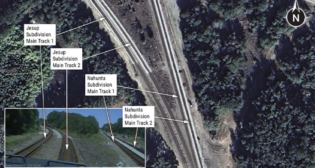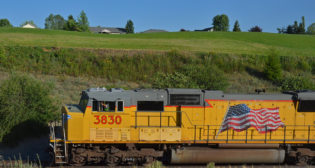
The short, the long, the skinny, and the fat
Written by David Schanoes, Contributing EditorExecutive Summary: After one year of investigation, the National Transportation Safety Board has determined that the cause of the fatal derailment of Amtrak train 188 at Frankford Junction is exactly the same as the cause determined within eight hours by everyone who knows anything about railroading.
An uncharitable, unenlightened, insensitive (“crusty” might be the term), fossilized, rigid, authoritarian dinosaur-type might say that’s the lesson for those of us in this business, the business of safe train operations, and improving the level of safety in train operations.
Fortunately, as time marches on, more and more of the dinosaur sorts retire or die or both, so there are fewer and fewer saying those sorts of things. But …
It doesn’t take a dinosaur type to tell you sensitive, intelligent, modern, flexible, biped types to not be distracted by the claims of NTSB to authority and expertise; to tell you, those still involved with and responsible for safe train operations: Do not delay your own investigation and determination of cause; do not postpone your own investigation and disciplinary processes. NTSB is not going to tell you anything 12 months from the incident that you won’t already know within a day or two, if you do your work, and if you don’t abdicate your responsibility. And…
And if you do delay? Well, for one, you’re going to look stupid (which I believe is the worst thing that could ever befall any railroad officer), and for another and far more important thing, you’ll be doing your operation, your employees, your customers and your passengers a disservice.
So, returning to this specific incident, the locomotive engineer of 188 lost “situational awareness” (non-dinosaur-speak for “lost track of where he was”), continued to accelerate the train when he should have been decelerating for the curve at Frankford Junction, realized his mistake too late when the train speed was 106 mph instead of 50 mph, and derailed the train.
No rocks hit the windshield of 188. No track defects or signal failures. No sleep apnea. No fatigue. No sabotage. No terrorism. No changes to schedules and abbreviation of rest periods. No lack of another person in the cab. No knocking himself out on the control stand. None of that. None. Just human error. Just like we, dinosaurs and humans alike, knew.
Call it loss of situational awareness, if you want. I like calling it what it is—failure to properly control the speed of the train, no matter what.
Contributing factors, secondary causes? This is where the “money” is in the investigation business, and like money in the markets, much of it winds up in speculation.
NTSB, in making its determination of the cause, availed itself of the services of Stephen M. Jenner, Ph.D., to investigate and determine the human performance issues involved in this derailment. Jenner’s presentation begins with a question: Since the locomotive engineer did in fact lose focus, or situational awareness, what factors “may have diverted his attention”?
Cue the stoning of SEPTA train 769 at a point several miles west of the point of derailment, and several more minutes before the derailment.
Doctor Jenner concludes that this other incident and the resulting radio conversations between train 769 and the train dispatcher is no longer something that may have diverted the engineer’s attention, that may have contributed to a loss of situational awareness.
So now, the loss of situational awareness is the cause of the loss. The engineer’s failure was “likely due to his attention being diverted to a SEPTA train emergency.”
We’ve gone from speculation to assertion to confirmation, and we’ve done all this based on … evidence? Not exactly. Actually, not even close.
The basis for Dr. Jenner’s determination is not available information as much as it is the lack, the unavailability, of information.
The locomotive engineer on 188 has no memory of his acceleration of the train to 80 mph and then to 106 mph. The transcript of the interview with engineer, available in NTSB Docket DCA 15MR010, quotes him:
“Unfortunately, the last memory I have on the way back is approaching and passing the platforms in North Philadelphia. I remember turning on the bell, and the next thing that I remember is when I came to my senses I was standing up in the locomotive cab after the accident.”
According to the NTSB presentation (download it at the link below), the initial transmission between the SEPTA train and the control center occurs at 21:13:11. Dr. Jenner claims that those conversations last for 6 minutes, with the final conversation at 21:19:13. Actually, Dr. Jenner is mistaken. The final conversation between SEPTA train 769 and the train dispatcher, according to Dr. Jenner’s own Human Factor Group’s Factual Report (available also in the docket) took place at 21:18:01. A subsequent remark, made a minute later—unidentified in origin or source and consisting of an indiscernible transmission—produced the following (from page 6 of the report): Second Person [laughs]: “Yeah, we got rocked.”
Examination of the event recorder download shows that 188’s engineer did sound the horn and ring the bell when passing the location of the SEPTA train, a series of short blasts from about 21:16:18 until 21:16:49. The locomotive engineer, it should be noted, sounded the horn properly. A series of short sounds is allowed in the NORAC rulebook “as an alarm when persons or livestock are on the track … In addition, use [this] to warn railroad employees when an emergency exists …” So for at least the first 3 or 4 minutes of the emergency conversations, 188’s engineer was focused, was operating the train properly, and was not distracted from performing his assigned duties.
And after that? The event recorder shows that the engineer does remember correctly—he did properly sound the locomotive bell when passing North Philadelphia station. In fact, the event recorder shows that he operated the train at the proper speed for another 3 minutes after passing SEPTA 769, until about 21:20:00.
At that point, the engineer continues to accelerate instead of throttling off and decelerating the train for the curve at Frankford Junction. The locomotive engineer maintains this improper acceleration for approximately 35 seconds until, realizing his error, he initiates an emergency brake application.
Dr. Jenner believes, and wants you dinosaurs and humans alike to believe, that although the locomotive engineer can’t remember what happened or why, that although the locomotive engineer operated his train properly throughout the period of the emergency radio communications and for another 3 minutes after the communications ended, that the likely cause of the engineer’s loss of situational awareness is the distraction of the radio communications between SEPTA 769 and the train dispatcher.
I don’t know about you humans, but we dinosaurs aren’t buying it. We dinosaurs, cold-blooded, fish-eyed, think we need to stick with what we know, not with what we might speculate. We dinosaurs think that we are either guided by the data directly applicable to this accident, or we aren’t. If we’re not, then we’re wasting time, taking a year instead of one day to determine a cause. We’re wasting money and we’re chasing phantoms, because, in fact, railroad radio communications are not distracting.
Radio communications are integral to safe train operations. You might as well be claiming that the operation of other trains is distracting, and that we need to isolate every locomotive engineer from the work environment he or she is trained to assess and respond to. We might as well quit railroading altogether. That’s where speculation gets you back to the Stone Age.



